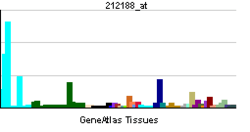KCTD12
| Potassium channel tetramerization domain containing 12 | |||||||||||||
|---|---|---|---|---|---|---|---|---|---|---|---|---|---|
| Identifiers | |||||||||||||
| Symbols | KCTD12 ; C13orf2; PFET1; PFETIN | ||||||||||||
| External IDs | OMIM: 610521 MGI: 2145823 HomoloGene: 16316 GeneCards: KCTD12 Gene | ||||||||||||
| |||||||||||||
| RNA expression pattern | |||||||||||||
 | |||||||||||||
 | |||||||||||||
| More reference expression data | |||||||||||||
| Orthologs | |||||||||||||
| Species | Human | Mouse | |||||||||||
| Entrez | 115207 | 239217 | |||||||||||
| Ensembl | ENSG00000178695 | ENSMUSG00000098557 | |||||||||||
| UniProt | Q96CX2 | Q6WVG3 | |||||||||||
| RefSeq (mRNA) | NM_138444 | NM_177715 | |||||||||||
| RefSeq (protein) | NP_612453 | NP_808383 | |||||||||||
| Location (UCSC) | Chr 13: 77.45 – 77.46 Mb | Chr 14: 102.98 – 102.98 Mb | |||||||||||
| PubMed search | |||||||||||||
BTB/POZ domain-containing protein KCTD12 is a protein that in humans is encoded by the KCTD12 gene.[1][2]
References
- ↑ Resendes BL, Kuo SF, Robertson NG, Giersch AB, Honrubia D, Ohara O, Adams JC, Morton CC (Sep 2004). "Isolation from cochlea of a novel human intronless gene with predominant fetal expression". J Assoc Res Otolaryngol 5 (2): 185–202. doi:10.1007/s10162-003-4042-x. PMC 2538407. PMID 15357420.
- ↑ "Entrez Gene: KCTD12 potassium channel tetramerisation domain containing 12".
Further reading
- Andersson B, Wentland MA, Ricafrente JY et al. (1996). "A "double adaptor" method for improved shotgun library construction.". Anal. Biochem. 236 (1): 107–13. doi:10.1006/abio.1996.0138. PMID 8619474.
- Bonaldo MF, Lennon G, Soares MB (1997). "Normalization and subtraction: two approaches to facilitate gene discovery.". Genome Res. 6 (9): 791–806. doi:10.1101/gr.6.9.791. PMID 8889548.
- Yu W, Andersson B, Worley KC et al. (1997). "Large-scale concatenation cDNA sequencing.". Genome Res. 7 (4): 353–8. doi:10.1101/gr.7.4.353. PMC 139146. PMID 9110174.
- Strausberg RL, Feingold EA, Grouse LH et al. (2003). "Generation and initial analysis of more than 15,000 full-length human and mouse cDNA sequences.". Proc. Natl. Acad. Sci. U.S.A. 99 (26): 16899–903. doi:10.1073/pnas.242603899. PMC 139241. PMID 12477932.
- Ota T, Suzuki Y, Nishikawa T et al. (2004). "Complete sequencing and characterization of 21,243 full-length human cDNAs.". Nat. Genet. 36 (1): 40–5. doi:10.1038/ng1285. PMID 14702039.
- Bouwmeester T, Bauch A, Ruffner H et al. (2004). "A physical and functional map of the human TNF-alpha/NF-kappa B signal transduction pathway.". Nat. Cell Biol. 6 (2): 97–105. doi:10.1038/ncb1086. PMID 14743216.
- Ballif BA, Villén J, Beausoleil SA et al. (2005). "Phosphoproteomic analysis of the developing mouse brain.". Mol. Cell Proteomics 3 (11): 1093–101. doi:10.1074/mcp.M400085-MCP200. PMID 15345747.
- Gerhard DS, Wagner L, Feingold EA et al. (2004). "The status, quality, and expansion of the NIH full-length cDNA project: the Mammalian Gene Collection (MGC).". Genome Res. 14 (10B): 2121–7. doi:10.1101/gr.2596504. PMC 528928. PMID 15489334.
- Kimura K, Wakamatsu A, Suzuki Y et al. (2006). "Diversification of transcriptional modulation: large-scale identification and characterization of putative alternative promoters of human genes.". Genome Res. 16 (1): 55–65. doi:10.1101/gr.4039406. PMC 1356129. PMID 16344560.
- Ewing RM, Chu P, Elisma F et al. (2007). "Large-scale mapping of human protein-protein interactions by mass spectrometry.". Mol. Syst. Biol. 3 (1): 89. doi:10.1038/msb4100134. PMC 1847948. PMID 17353931.